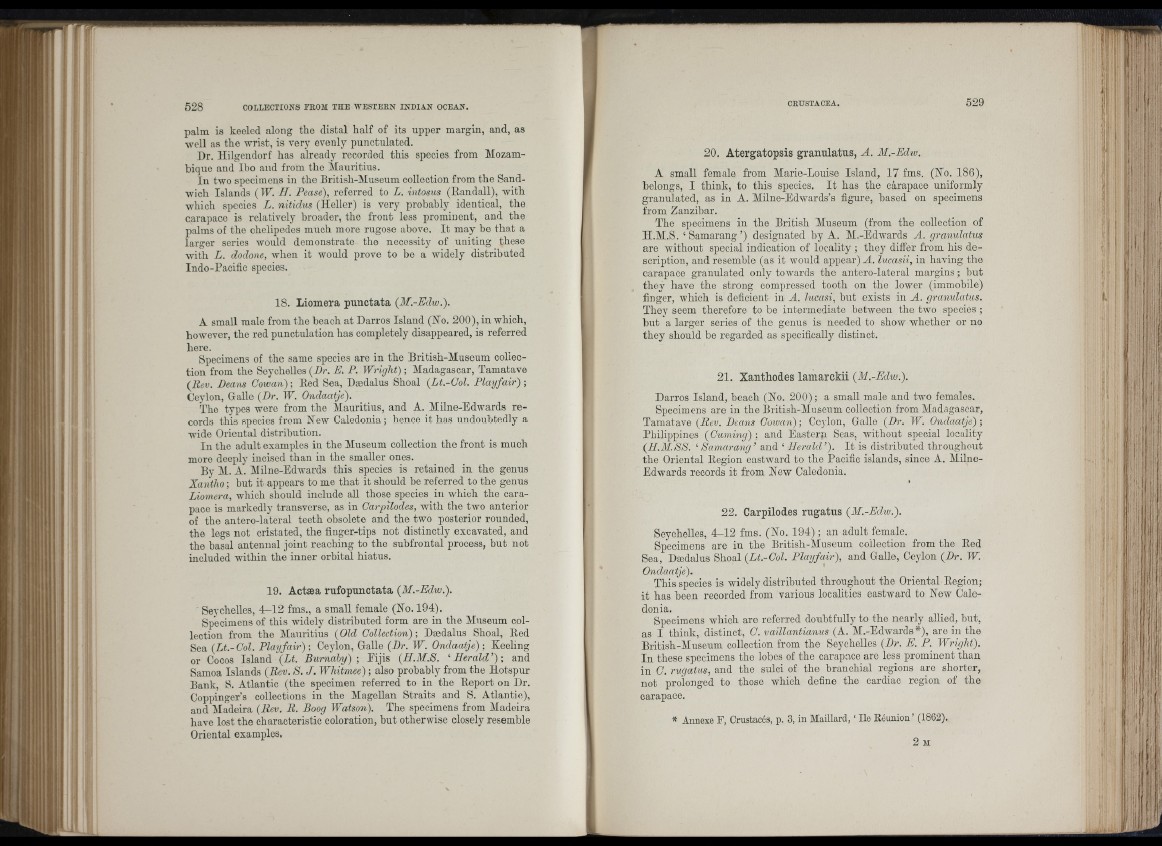
I l îi
!! s i J
i
il)
!!
IL
llll
il
I
1 «lli
I
'11 :
id«
1»
JUl! ,
ItlR
palm is keeled along the distal half of its upper margin, and, as
well as the wrist, is very evenly punctulated.
Dr. Hilgendorf has already recorded this species from Mozambique
and Ibo and from the Mauritius.
In two specimens in the Britisb-AIuseum collection from the Sandwich
Islands (IF". A. Pease), referred to L. intosus (Randall), witb
wbicb species L. nitidus (Heller) is very probably identical, tbe
carapace is relatively broader, tbe front less prominent, and tbe
palms of tbe chelipedes much more rugose above. I t may be th at a
larger series would demonstrate the necessity of uniting these
with L. dodone, when it would prove to be a widely distributed
Indo-Pacific species.
18. Liomera punctata (M.-Edw.).
A small male from the beach at Darros Island (No. 200), in which,
however, tbe red pnnctnlation has completely disappeared, is referred
here.
Specimens of tbe same species are in tbe British-Museum collection
from tbe Seychelles (Dr. E, P. Wright); Aladagascar, Tamatave
(liev. Deans Cowan); Red Sea, Daedalus Shoal (Lt.-Col. Playfair);
Ceylon, Galle (Dr. W. Ondaatje).
Tbe types were from tbe Alauritius, and A. Milne-Edwards re cords
tbis species from New Caledonia; hence it has undoubtedly a
wide Oriental distribution.
In tbe adult examples in tbe Aluseum collection the front is much
more deeply incised than in tbe smaller ones.
By AI. A. Alilne-Edwards tbis species is retained in tbe genus
Xantho; but it appears to me th at it should be referred to tbe genus
Liomera, which should include all those species in which tbe carapace
is markedly transverse, as in Carpilodes, with the two anterior
of the antero-lateral teeth obsolete and tbe two posterior rounded,
the legs not cristated, the finger-tips not distinctly excavated, and
tbe basal antennal joint reaching to the subfrontal process, but not
included within tbe inner orbital hiatus.
19. Actæa rufopunctata (M.-Edw.).
Seychelles, 4 -12 fms., a small female (No. 194).
Specimens of tbis widely distributed form are in the Aluseum collection
from tbe Alauritius (Old Collection); Daedalus Shoal, Red
Sea (Lt.-Col. Playfair); Ceylon, Galle (Dr. W. Ondaatje); Keeling
Cocos Island (Lt. Burnaly) ; Eijis (H.or M.S. ‘Herald’); and
Samoa Islands (Rev. S. J. Whitmee); also probably from tbe Hotspur
Bank, S. Atlantic (tbe specimen referred to in tbe Report on Dr.
Coppinger’s collections in the Magellan Straits and S. Atlantic),
and Aladeira (Rev. R . Boog Watson). The specimens from Aladeira
have lost tbe characteristic coloration, but otherwise closely resemble
Oriental examples.
20. Atergatopsis granulatus, A . AI.-Edw.
A small female from Alarie-Louise Island, 17 fms. (No. 186),
belongs, I think, to this species. I t has tbe carapace uniformly
granulated, as in A. Milne-Edwards’s figure, based on specimens
from Zanzibar.
Tbe specimens in the British Museum (from the collection of
H.M.S. ‘ Samarang ’) designated by A. Al.-Edwards A. granulatus
are without special indication of locality ; they differ from his description,
and resemble (as it would appear) A. lucasii, in having the
carapace granulated only towards tbe antero-lateral margins ; but
they have tbe strong compressed tooth on tbe lower (immobile)
finger, which is deficient in A . lucasi, bnt exists in A . granidatus.
They seem therefore to be intermediate between the two species ;
bnt a larger series of the genus is needed to show whether or no
they should be regarded as specifically distinct.
21. Xanthodes lamarckii (M.-Edw.).
Darros Island, beach (No. 200); a small male and two females.
Specimens are in the Britisb-AIusenm collection from Aladagascar,
Tamatave (Rev. Deans Ooivan); Ceylon, Galle (Dr. W. Ondaatje) ;
Philippines (Cuming); and Eastern Seas, without special locality
(H.AI.SS. ‘Samarang’ and ‘Herald’). I t is distributed tbrougbout
tbe Oriental Region eastward to tbe Pacific islands, since A. Alilne-
Edwards records it from New Caledonia.
22, Carpilodes rugatus (M.-Edw.).
Seychelles, 4-12 fms. (No. 194); an adult female.
Specimens are in tbe British-Aluseum collection from tbe Red
Sea, Daidalus Shoal (Lt.-Col. Playfair), and Galle, Ceylon (Dr. W.
Ondaatje).
This species is widely distributed tbrougbout tbe Oriental Region;
it has been recorded from various localities eastward to New Caledonia.
Specimens which are referred doubtfully to tbe nearly allied, bnt,
as I think, distinct, C. vaillantianus (A. Al.-Edwards*), are in the
British-AInseum collection from tbe Seychelles (Dr. E. P. Wright).
In these specimens tbe lobes of the carapace are less prominent than
in C. rugatus, and tbe sulci of the branchial regions are shorter,
not prolonged to those which define tbe cardiac region of tbe
carapace.
* Annexe F, Crustacés, p. 3, in Maillard, ‘ He Réunion’ (1862).
2 M
te
I' Vi.tei
m\